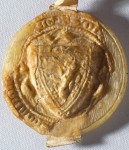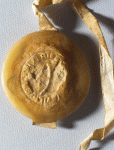Two letters that are thought to have passed through the hands of Scottish national hero William Wallace will go on display this August at the Scottish Parliament as part of its annual Festival of Politics. These are the only two surviving documents that are directly connected to Wallace and neither of them is actually owned by Scotland, so to see them both together in the motherland is a once in a lifetime opportunity.
One letter, known as the Safe Conduct or the Wallace Letter, was written on November 7th, 1300 by King Philip IV of France to his representatives in Rome. Wallace had left Scotland for France in the fall of 1298 after his defeat at the Battle of Falkirk and his resignation as Guardian of Scotland in favour of Robert the Bruce. Written in Latin, the letter commands that the King’s ambassadors ask Pope Boniface VIII to agree to Wallace’s requests.
Here’s a translation of the letter:

Philip by the grace of God, king of the French, to his beloved and loyal people appointed at the Roman Court, greetings and favour. We command you that you ask the Supreme Pontiff to consider with favour our beloved William le Walois of Scotland, knight, with regard to those things which concern him that he has to expedite. Dated at Pierrefonds on the Monday after the feast of All Saints [7 November 1300]. [Endorsed]: Fourth letter of the King of France.
So it’s not really a safe conduct so much as a King asking a third part to support his ally. The reason it’s called the Safe Conduct is that English records note that Wallace was carrying three safe conducts when he was arrested, one from the King of France, one from the King of Norway and one from the King of Scotland. It was last referred to in an inventory of English records in 1323 then faded in the mists of time until the letter was discovered in the Tower of London in 1820.
We can’t know with certainty that this document is the French safe conduct taken from William Wallace after his arrest. It could have been intercepted by spies, for instance. However, the letter does indicate that Wallace was going to appeal to the Pope in person so it makes sense that he would have carried it on him rather than Philip sending it directly, and given that it was found in the Tower, it makes sense that it was confiscated from one the Tower’s most famous residents.


The second letter is known as the Lübeck Letter and is the only surviving document we have that was written by William Wallace himself. Attached to this letter is also the only surviving example of Wallace’s personal seal. It has a Scottish Lion rampant on the front and a strung bow with arrow on the reverse.
After Scottish forces led by William Wallace and his northern ally Andrew de Mornay (aka Andrew Murray) won the Battle of Stirling Bridge on September 11, 1297, Wallace (Mornay was mortally wounded in the battle, although it appears he lived for a short time afterwards and Wallace continued to include his name in correspondence until his death) wasted no time trying to get the Scottish economy back on track. The British had captured Scottish ports the year before and severely curtailed trade. Exactly a month after Stirling Bridge, Wallace felt secure enough to write to the Hanseatic League towns of Hamburg and Lübeck alerting them that Scotland’s ports were open for business again.

Andrew Moray and William Wallace, leaders of the army of the Kingdom of Scotland and the Community, to their worthy and beloved friends, the Mayors and citizens of Lübeck and Hamburg, greeting. We have been told by trustworthy merchants of the Kingdom of Scotland that you are giving help and favour in all business concerning us and our merchants for which we thank you. We ask that it be made known among your merchants that they will now have safe access to all ports in the Kingdom of Scotland, since Scotland, blessed be God, has been rescued from the power of the English by force of arms. Given at Haddington in Scotland, on the 11th day of October in the year of grace one thousand two hundred and ninety seven.
The Hamburg letter was destroyed in World War II. The Lübeck Letter survived secreted away in a Hanseatic League archive in a Lübeck museum. It is now kept in the National Archives of Lübeck who have loaned it to Scotland for the exhibit.
The Scottish government has long yearned for both letters. Members of Parliament have requested that the National Archives in Kew and Lübeck donate the letters to Scotland. That hasn’t happened, although Kew has agreed to a long-term loan of the Safe Conduct letter. Since both documents are extremely fragile, they will be exhibited for a short time only. The exhibition is free and will be open from August 10 to August 31, 2012, in the Scottish Parliament Building’s Main Hall.
